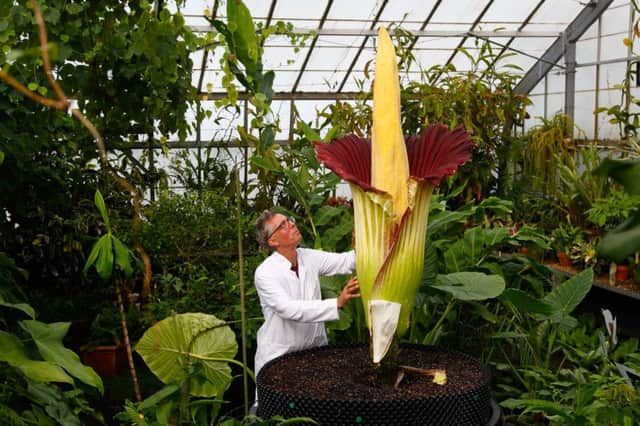World’s smelliest plant to blossom for third time in Edinburgh


Amorphophallus titanum, also known as the corpse flower, is a rare and endangered specimen currently grown in the tropical glasshouse at the Royal Botanic Garden Edinburgh which has only flowered twice previously, in 2015 and 2017.
The plant gets its name from the stench of rotting flesh it emits while it is in full bloom, intended to attract pollinators which feed on dead wild animals or lay their eggs in rotting meat.
Advertisement
Hide AdAdvertisement
Hide AdThe stench has also been described as smelling strongly of cheese, rotting fish, sweaty socks and faeces.
Experts calculate that it will flower at the end of June for around a week, with the first few days being the most pungent.
Bringing it to the point of flowering has involved the glasshouse team replicating the conditions it would experience in its native country. In the wild it grows only in the Bukit Barisan range of mountains in West Sumatra where the climate is very humid and hot.
The plant was gifted to Scotland in 2003 in the form of a corm which was the size of an orange. When it was most recently measured in 2010 it weighed 153.9kg, making it the largest ever recorded.
Advertisement
Hide AdAdvertisement
Hide AdIt recently started growing at a rate of around 14cm per day, and now stands at nearly two metres tall.
Before producing its first flower in 2015, it had to be nurtured for 12 years at in the tropical greenhouse at the Royal Botanic Garden.
On the two previous occasions that the plant has bloomed, thousands of visitors have flocked to experience the smell before it subsided and the plant drooped.
Louise Galloway, Glasshouse Supervisor, said: “The Amorphophallus titanum can be difficult to grow to flowering stage and they usually take about seven to ten years to reach maturity.
Advertisement
Hide AdAdvertisement
Hide Ad“Often after flowering and setting seed in the wild the plant’s energy is exhausted and it dies.
“We have been very lucky to have a stable corm, which has produced a consistent flower every two years since maturing.”
The initial bloom is expected to occur at night and give off the strongest smell when it first opens.
Plans are already being formed to allow members of the public access late at night to experience “peak pungency”.
Advertisement
Hide AdAdvertisement
Hide AdDr Mark Hughes, RBGE Tropical Botanist, said: “Its flowering here at RBGE for the third time symbolises our long-term commitment to the research and conservation efforts in that region.”
While the Latin name literally translates as “giant misshapen penis”, the more commonly known name “titan arum” was developed by Sir David Attenborough while filming The Private Life of Plants, as the Latin name was thought inappropriate for a BBC audience.
In 2018 the plant species was classified as endangered due to habitat loss.